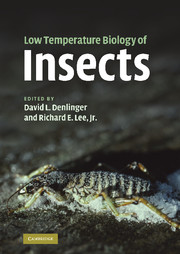13 - A template for insect cryopreservation
from PART III - PRACTICAL APPLICATIONS
Published online by Cambridge University Press: 04 May 2010
Summary
Introduction
While there is a growing number of insect species that have been successfully cryopreserved during the almost two decades that have elapsed since publication of Insects at Low Temperature, practical use of the methodology has generally not been forthcoming. The benefits of having the capability to place insects into storage indefinitely are considerable, ranging from reducing rearing costs to preserving valuable genetic resources. However, traditional continuous rearing practices still prevail as the primary means to maintain multiple colonies of insects, even though cryopreservation protocols for some species are now available. It is understandable that scientists and insectary managers would be reluctant to make significant changes in rearing methods without adequate assurance that irreplaceable research stocks or production lines were not lost. With this in mind, we wish to use this communication to demonstrate how a cryopreservation protocol is developed and utilized for practical applications. Thus, we hope to help alleviate the concerns about the use of existing protocols and stimulate additional research on developing cryogenic technology for the long-term storage of insects important to agriculture and the scientific community.
The insect used as the example for this case study is the New World Screwworm, Cochliomyia hominivorax, an ectoparasitic calliphorid that causes myiasis in man and animals (Bishopp, 1915). It is the first insect to be eliminated through an area-wide release of mass-produced sterile insects and it no longer exists in North and Central America (Wyss, 2000).
- Type
- Chapter
- Information
- Low Temperature Biology of Insects , pp. 325 - 341Publisher: Cambridge University PressPrint publication year: 2010
References
- 12
- Cited by



